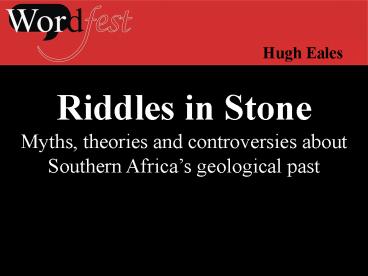Hugh Eales - PowerPoint PPT Presentation
1 / 6
Title:
Hugh Eales
Description:
Riddles in Stone Myths, theories and controversies about Southern Africa's ... is that in our search for answers to fundamental questions about our Earth, ... – PowerPoint PPT presentation
Number of Views:51
Avg rating:3.0/5.0
Title: Hugh Eales
1
Hugh Eales
Riddles in Stone Myths, theories and
controversies about Southern Africas geological
past
2
Featured work
This book, written in everyday, non-technical
language, is about some of the many fascinating
controversies in Earth Science - controversies
between different groups of geologists on the one
hand, and between geologists and biologists,
physicists and the Christian Church on the
other. Some of these controversies arose many
centuries, even millennia ago, while others have
emerged within the present decade. How old is
our Earth? Do we see an apocalyptic end to the
World, and if so, how might this come about?
What geological evidence, if any, is there for
Noahs Flood? Was life brought to our planet from
extraterrestrial sources, or did it evolve
spontaneously on Earth by chemical reactions
catalysed by crystalline minerals? What are
fossils, and how do they contribute to the great
debate on theories of evolution?
3
Featured work
Then there are unanswered, or only partly
answered questions about the origin of deposits
of diamonds, gold, platinum-group metals, copper
and base metals in Southern Africa, a region as
wonderfully endowed with Natures mineral riches
as any area on Earth. Who were the Ancients who
mined gold in Zimbabwe more than a millennium
ago, and could this territory have been the
Biblical Ophir? Is asbestos as dangerous a
material as is claimed in some quarters? Again,
the spectre of global warming and climate change
focuses our attention at the present time on
water - either the rising of sea levels that
could overwhelm all low-lying countries, or on
devastating droughts that Schwarzs ill-fated
Kalahari Scheme sought in the 1920s to alleviate
in Southern Africa.
4
Featured work
The thrust of this book is that in our search for
answers to fundamental questions about our Earth,
startling differences of opinion are inevitable.
No ground more fertile for the growth of
controversy exists. The geologist is faced with
the problem of interpreting events that took
place thousands to billions of years ago, often
at depths below the surface which we have little
hope of ever reaching. We learn, therefore, that
consensus amongst a majority is at any one time
proof of nothing - the majority may often be
hopelessly wide of the mark. The introduction
of fresh ideas (as in the Plate Tectonic model)
or new techniques (as in the dating of rocks
using radioactive decay) can often re-align the
thrust of science, and lead to the abandonment
of traditional ideas.
5
Biography
Hugh Eales completed his undergraduate years and
M.Sc. at Rhodes in 1952, before becoming a
mining and field geologist in East Africa and
Zimbabwe. Returning to Rhodes in 1958 to complete
a doctorate, he was in 1970 given the Chair of
Geology there, a position he held until
retirement in 1993. During these years he served
on many national and international bodies, was
elected Vice-Chairman of the Mineralogical
Association of SA in the year of its foundation
(1980), Chairman in 1981, and National Convenor
for the CSIR Research Programme on Layered
Complexes (1985-88). In 1978 he founded the
School of Exploration Geology at Rhodes, in
which some 170 professional geologists from 25
countries world-wide have now earned specialized
post-graduate degrees. He has spent sabbaticals
at the Universities of Cambridge, Princeton,
Wisconsin and Oregon.
6
Biography
Hugh has published some 80 full-length scientific
papers and books in a variety of fields. His
Introduction to the Bushveld Complex was cited by
the SA Council for Geoscience in 2006 as their
best-selling book. As relief from the world of
academia, he was President of both the Rhodes
University (1989-94) and Grahamstown City
(1994-97) Golf Clubs. Other interests include fly
fishing (in SA, Ireland and New Zealand) and
gardening.




















![Next 4 weeks: Atmospheric temperature profiles Stability [1-week on Fronts from Hugh Pumphrey] Thunderstorms Air Pollution PowerPoint PPT Presentation](https://s3.amazonaws.com/images.powershow.com/7778677.th0.jpg?_=20160426096)


![[love song ga dekirumade] Cast. Alex Fletcher-Hugh Gran PowerPoint PPT Presentation](https://s3.amazonaws.com/images.powershow.com/P1246072935iGfBk.th0.jpg?_=20130603071)







